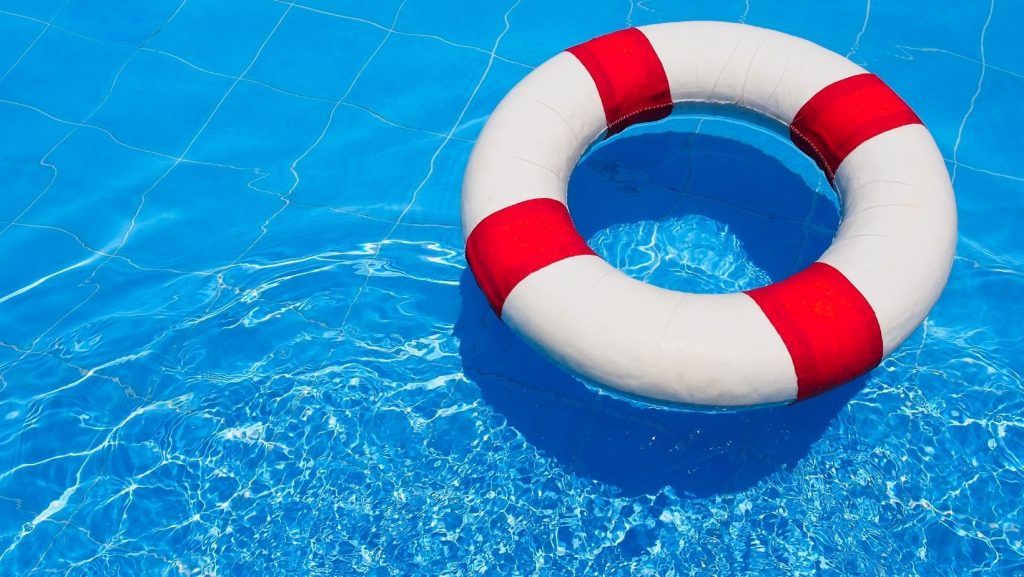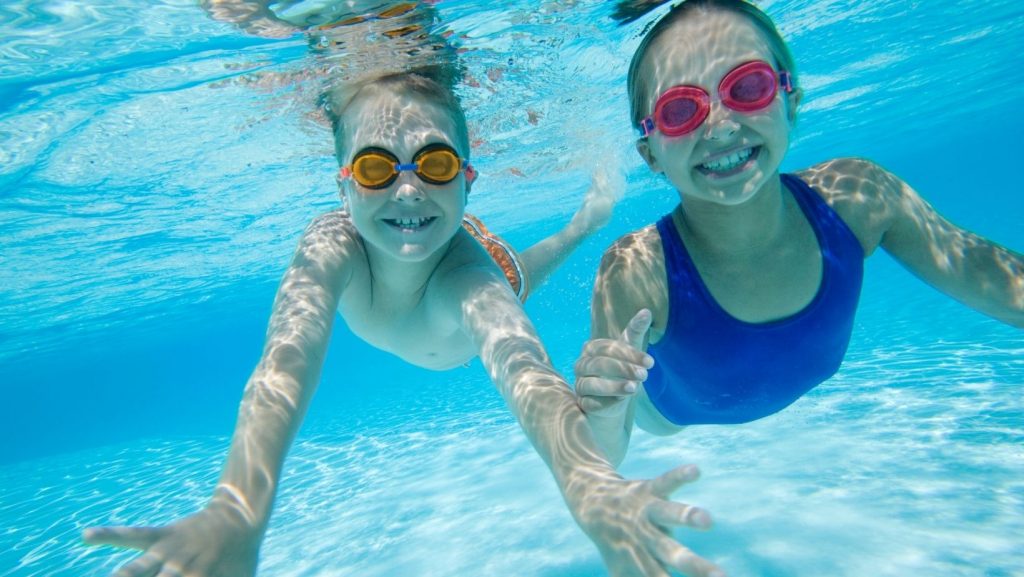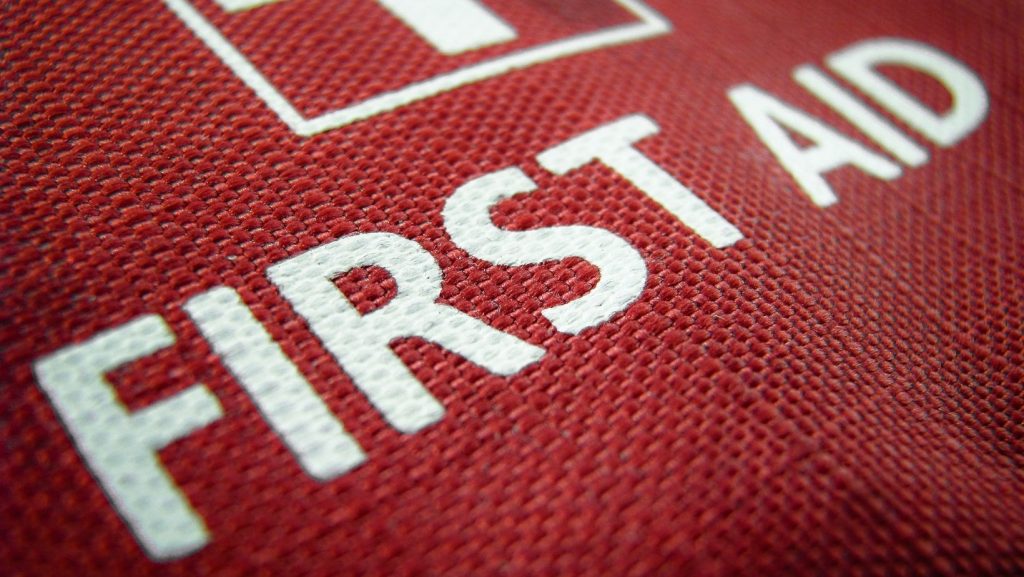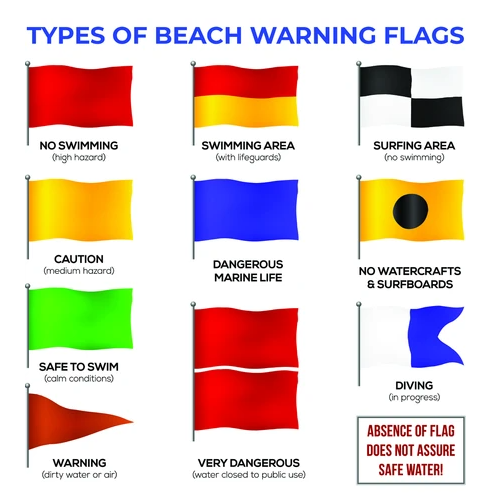
Swimming Unit Study and Badge Resources
Use this Swimming unit study to help you earn the Swimming badge. Other badges you may wish to earn alongside include the Water Safety badge, the Sports (Swimming) badge or the Water Games badge.
This badge should be earned under the supervision of an adult trained in this subject. Use common sense when completing requirements.

Rules for Water Safety
Before jumping in the water, learning basic water safety rules is a must. This list is by no means all inclusive but should give you a good starting point.
- The best way to stay safe in the water is to learn to swim.
- Know what the depth markers mean in large or public pools.
- Test the water temperature before you plunge in. Cold water can shock your body and make your blood pressure and heart rate go up. Cold water can also slow your muscles, making it hard to swim.
- Pool gates are there to protect you. Never go through a pool gate unless an adult is with you.
- Always obey all pool rules.
- Always walk in a pool area, do not run.
- Never swim without a buddy
- Never dive into shallow or murky water
- Never dive into water with submerged obstacles such as rocks or trees.
- Never swim without an adult present
- Swim at a depth that is safe for you. If you’re just learning to swim, stay in the shallow end.
- If you swim in a pond, lake, or river the fish swimming around won’t hurt you. There may hidden jagged rocks, broken bottles, or trash however. Wear something to protect your feet. Also, watch out for mud, weeds and grass, which can trap even a good swimmer. If you panic and try to yank yourself free, you may get even more tangled. Instead, shake and pull your arms and legs slowly to work yourself loose or call for an adult’s help.
- Don’t chew gum or eat while you swim — you could choke
- Stop swimming or boating as soon as you see or hear a storm. Remember, lightning is electricity — electricity and water are a dangerous combination.
- If you find yourself in trouble and someone comes to rescue you in deep water, remain calm and do not grab a hold of your rescuer. If you interfere with your rescuer you can both drown. Stay calm and let them “tow” you to safety.
To Do: Use the list above as a starting point and brainstorm a list of water safety rules. For each rule come up with, have the kids explain WHY that rule is important.
Fulfills requirement #1 for all levels

Different Strokes
When people think of swimming they generally think of a basic crawl stroke, but there are a wide variety of swimming strokes and each works best for different situations. Just as important as learning any stroke however is the importance of learning to float and tread water.
To Do: Learn the jellyfish or dead man’s float, also known as the survival float. This float helps to conserve energy if you do not have a lot of swimming stamina or if you are stranded in a large body of water. Then learn to float on your back.
Have a float contest with friends. Each person must float on their back and balance an object such as a pool ring on their belly. The last person to drop their ring wins.
To Do: Learn to recognize the following swimming strokes and know the benefits of each. All American Swim offers a great article on the proper form for each stroke as well as when each should be used and why.
- Freestyle or front crawl
- Backstroke
- Breast Stroke
- Side Stroke
- Butterfly
To Do: Using the stroke of your choice swim 10 feet if you are preschool or level 1, 50 feet if you are level 2 or 100 feet if you are level 3 or above.
Once you and your friends master different strokes, try having a race where each lap you must use a different swim stroke.
Fulfills requirement #1 for all levels.
Water Rescues
Did you know that in many cases a drowning person can easily drown their rescuer as well? When panicked, a drowning person may latch onto a rescuer so tightly that even though the person trying to rescue them can swim, they cannot do so with the victim holding on to them and both parties drown. For this reason it is important to learn proper water rescue techniques. It doesn’t do any good to try to help someone if get in trouble yourself. If you are not sure you can rescue the victim without putting yourself in danger, then go for help instead.
To Do: Learn the rhyme, “Reach or throw, don’t go.” From the American Red Cross. Use their 23 page workbook to teach basic water rescue for kids that includes fun activities and puzzles.
Fulfills level 2 and 3 requirement #2.

First Aid for Water Injuries
Swimming can be a lot of fun, but water can also be very dangerous. It is important to know how to treat common injuries that may occur when near water.
To Do: Learn the proper first aid for the following injuries. If you are learning with a group, try role playing.
- hypothermia
- dehydration
- heat reactions
- muscle cramps
- stings and bites
- cuts and scrapes
- spinal injuries
- hyperventilation.
Fulfills Level 3 requirement #2
Water Survival Skills
Learning to swim does not guarantee you safety in and around the water. Learning survival skills like the survival float can help, but if you fall in the water fully dressed, your clothes can weigh you down making floating nearly impossible.
To Do: Only level 3 and up should attempt this and only if they are strong swimmers with a trained adult standing by.
Jump into deep water wearing clothes (shoes, socks, bathing suit, long pants, and shirt). Show that you can remove your shoes and socks while treading water. Then remove and inflate your pants, and show that you can float using the pants for support. Swim for 5 minutes using your pants for support and demonstrate how to re-inflate your pants while using them for support. The video below will explain how to inflate your pants.
Fulfills Level 4 requirement #2
Swimming Animals
Humans are not the only animal that swims. How do other animals and insects move through the water?
To Do: Watch how different animals swim. How do they use their legs, fins, tails and bodies to propel themselves through the water? Try to imitate the animal actions while playing with your friends. Have someone shout out an animal and then everyone must try to swim like that animal. Different animals to consider include:
- Frog
- Otter
- Dolphin
- Dog
- Duck
- Fish
Fulfills optional requirement #3

Ocean Safety
Swimming in the ocean is much different than swimming in the family pool. Not all beaches recommended for swimming or wading. If you are swimming at a beach, first make sure you know what the ocean conditions are. Some beaches post colored flags, others may have a chalkboard or other method of communicating dangerous conditions. Know what rip currents and undertows are and how to survive them. Read through Reader’s Digest, 6 Things You Need to Know Before Swimming in the Ocean.
To Do: Learn what each of the safety beach flags mean. Full descriptions can be found at: Beachgoer.com. Make practice flags to quiz your friends. Note: In the United States the dive flag is usually red with a diagonal white stripe. Other than that, the flags below are accepted around the world.

To Do: Visit a beach to go swimming at. Before entering the water understand the ocean conditions for this particular beach as well as how the current weather and time of day my effect those conditions.
Fulfills optional requirement #4
Snorkeling
When swimming in the ocean, learning to snorkel will allow you to view all the amazing wildlife under the water. Practicing in a pool using a snorkel during water games like diving for rings will help you get comfortable with the equipment.
To Do: Learn how to choose a mask that fits your face and how to keep it from fogging. Learn to breathe with a snorkel and how to clear both your mask and snorkel. Learn how to properly walk in flippers.
Fulfills optional requirement #5
Follow our Facebook page for badge of the week posts and other resources. For planning purposes you can see which badges will be featured on our badge of the week calendar. You can also sort and search articles by topic on our main blog page. If you are not already a member, check out our membership pricing page.





